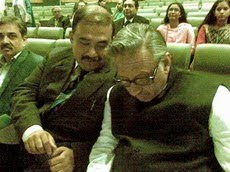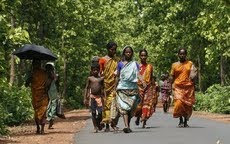 poses for their fortunes in West Bengal. Veteran Marxist leader and former Chief Minister Jyoti Basu, in his typical style, has already said : “Jot hole amader khoti hobe, asan Khombe”. Now his self proclaimed disciple , the maverick transport minister Subhas Chakrabarty has also said that the Left Front’s share of parliament seats would come down from 35 in the last 2004 polls to 28 seats in the ensuing elections. Which means he is conceding that the Congress-Trinamul Congress combine will win atleast 14 seats from among the total 42 in West Bengal. Needless to say, this time it is the Trinamul which will win most of these seats. In the last parliament, it won only one seat – Mamata Banerji barely managed to retain her South Kolkata constituency with a much reduced margin. The Congress may manage to retain all its former seats won in the last election or may loose a few and win a few new ones. The Trinamul leadership is confident it will win atleast half the seats in Bengal 21 out of 42. Publicly they say they will win 25.
poses for their fortunes in West Bengal. Veteran Marxist leader and former Chief Minister Jyoti Basu, in his typical style, has already said : “Jot hole amader khoti hobe, asan Khombe”. Now his self proclaimed disciple , the maverick transport minister Subhas Chakrabarty has also said that the Left Front’s share of parliament seats would come down from 35 in the last 2004 polls to 28 seats in the ensuing elections. Which means he is conceding that the Congress-Trinamul Congress combine will win atleast 14 seats from among the total 42 in West Bengal. Needless to say, this time it is the Trinamul which will win most of these seats. In the last parliament, it won only one seat – Mamata Banerji barely managed to retain her South Kolkata constituency with a much reduced margin. The Congress may manage to retain all its former seats won in the last election or may loose a few and win a few new ones. The Trinamul leadership is confident it will win atleast half the seats in Bengal 21 out of 42. Publicly they say they will win 25. That may be on the higher side. I still feel the Left will win more seats than the Trinamul-Congress combine. The Times of India says in a early assessment that the Trinamul-Congress combination will win 16 seats. The Intelligence Bureau is saying something similar . But I would go with Subhas Chakrabarty’s assessment. My own assessment, though it is a bit early is that the Trinamul Congress will win 9 to ten seats and the Congress will win 3 to 4. They would have done better but because the Trinamul’s gains in rural Bengal will be far offset by their losses in urban Bengal. In the towns and cities and even in the mofussil; the general perception of the middle class Bengali is that
That may be on the higher side. I still feel the Left will win more seats than the Trinamul-Congress combine. The Times of India says in a early assessment that the Trinamul-Congress combination will win 16 seats. The Intelligence Bureau is saying something similar . But I would go with Subhas Chakrabarty’s assessment. My own assessment, though it is a bit early is that the Trinamul Congress will win 9 to ten seats and the Congress will win 3 to 4. They would have done better but because the Trinamul’s gains in rural Bengal will be far offset by their losses in urban Bengal. In the towns and cities and even in the mofussil; the general perception of the middle class Bengali is that  Buddhadeb Bhattacharya’s government is trying to industrialise and create and Mamata Banerji is playing spoilsport. So these people who normally have voted against the Left will vote Left this time. They will vote for Brand Buddha.
Buddhadeb Bhattacharya’s government is trying to industrialise and create and Mamata Banerji is playing spoilsport. So these people who normally have voted against the Left will vote Left this time. They will vote for Brand Buddha.The Left’s real challenge is to hold its rural bastions. If the Bishnupur assembly by-elections are an indicator, the Left will find this really difficult in view of the Singur-Nandigram wind that is blowing . But the Singur-Nandigram wave is in rural South Bengal. Up in the north Bengal areas, the real issue is the Gorkhaland agitation and the threat to Bengal’s unity . In the north Bengal districts,
 both the Adivasi and the Bengali peasentry and townspeople will join hands to vote for the CPI(M) and the Left Front. That’s like 1980s when Jyoti Basu turned the Gorkhaland agitation on its head and used it to raise the spectre of a split of Bengal’s territory . “Abar Bangla bhag kora cholbe na” was the slogan the Left raised and that always strikes a sympathetic chord with the post-partition Bengali. In North Bengal, that may be used gainfully by the Left again, now that the Gorkhaland agitation is back on the streets of not only Darjeeling but also Dooars. So in all, I can see the Left still managing 25 seats surely and possibly two or three more. What will favour Mamata Banerji and the Congress is the anti Left sentiment in large parts of rural South Bengal in view of the land-for-industry controversy. The Left is also a much less organized force with its discipline severely suffering. Gone are the days when the Left could proudly say in Bengal if our supporters are disillusioned with us, it is on ideological grounds. Now MPs from Left parties go and join Trinamul Congress just because they have not got a party ticket; like Abu Ayash Mondal of Burdwan. So internal divisions in the Left will help the Trinamuls and the Congress.
both the Adivasi and the Bengali peasentry and townspeople will join hands to vote for the CPI(M) and the Left Front. That’s like 1980s when Jyoti Basu turned the Gorkhaland agitation on its head and used it to raise the spectre of a split of Bengal’s territory . “Abar Bangla bhag kora cholbe na” was the slogan the Left raised and that always strikes a sympathetic chord with the post-partition Bengali. In North Bengal, that may be used gainfully by the Left again, now that the Gorkhaland agitation is back on the streets of not only Darjeeling but also Dooars. So in all, I can see the Left still managing 25 seats surely and possibly two or three more. What will favour Mamata Banerji and the Congress is the anti Left sentiment in large parts of rural South Bengal in view of the land-for-industry controversy. The Left is also a much less organized force with its discipline severely suffering. Gone are the days when the Left could proudly say in Bengal if our supporters are disillusioned with us, it is on ideological grounds. Now MPs from Left parties go and join Trinamul Congress just because they have not got a party ticket; like Abu Ayash Mondal of Burdwan. So internal divisions in the Left will help the Trinamuls and the Congress.But the sentiment in North Bengal is largely determined by the Gorkhaland threat – something that surprisingly unites the Bengalis and the Adivasis. That will help the Left. Also Mamata’s opposition to industrialization , her image as a spoilsport will adversely affect the Trinamul and the Congress and benefit the Left.
 The delimitation of the parliament constituencies and the way many of these have a thick urban component now may work, atleast marginally, in the Left’s favour. Because the proposed industries like the Tata car factory at Singur would have brought maximum benefit to the mofussil areas, the ganj area , rather than the towns or the villages. Many people in these areas, except the hardcore farmer, will vote Left.
The delimitation of the parliament constituencies and the way many of these have a thick urban component now may work, atleast marginally, in the Left’s favour. Because the proposed industries like the Tata car factory at Singur would have brought maximum benefit to the mofussil areas, the ganj area , rather than the towns or the villages. Many people in these areas, except the hardcore farmer, will vote Left.The BJP has been getting about ten percent popular vote in West Bengal. This is not so much an ideological Sangh Parivar vote but more of an anti-Left vote that slowly developed when the BJP ruled the Centre. If the Trinamul and Congress skillfully manage to woo the BJP voter by projecting the need for a unified anti-Left vote in Bengal to torpedo the Left ( and the BJP nationally would like a less dominant Left in Delhi ), then the Mahajot would better than what most of us expect. Only if they manage to get almost the entire BJP vote in Bengal into their kitty would the Trinamul- Congress combine win more than 20 seats – because that would take their voteshare well past the forty-one to forty-two percent mark. At that level of vote-share , they would pose the most formidable challenge that the Left has ever faced in Bengal.
 I can see large number of Muslims shifting to the Mahajot. Mamata’s secular image and her breakup with the BJP-led NDA, the alliance with the Congress which is very strong in several Muslim areas like Maldah and Murshidabad, the Left’s loosing minority base in farming areas like Nandigram will all help the Mahajot. The Muslims also want a stable secular government at the Centre. They would vote for the Congress and Trinamul alliance in large numbers also because the Left is not seen as capable of forming a government in Delhi.
I can see large number of Muslims shifting to the Mahajot. Mamata’s secular image and her breakup with the BJP-led NDA, the alliance with the Congress which is very strong in several Muslim areas like Maldah and Murshidabad, the Left’s loosing minority base in farming areas like Nandigram will all help the Mahajot. The Muslims also want a stable secular government at the Centre. They would vote for the Congress and Trinamul alliance in large numbers also because the Left is not seen as capable of forming a government in Delhi. This may be a watershed election in Bengal . If the Left looses more than half the seats, as the Trinamul leaders claim will happen, then they may well be looking to further erosion of support by the time Bengal goes for a state assembly poll in 2011. This may not be the beginning of the end but perhaps the beginning of the toughest challenge the Left has faced since coming to power in 1978.
(Subir Bhaumik is the BBC's East India Correspondent)







